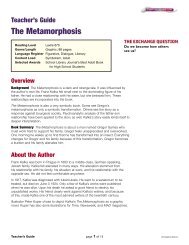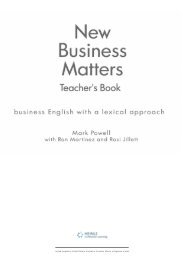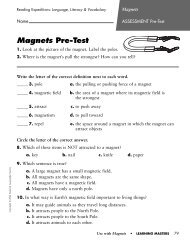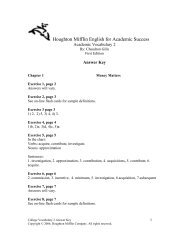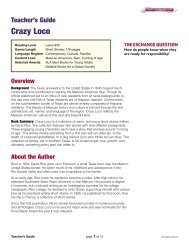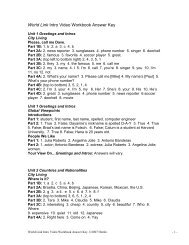English for Cabin Crew Trainer's Guide - Heinle
English for Cabin Crew Trainer's Guide - Heinle
English for Cabin Crew Trainer's Guide - Heinle
Create successful ePaper yourself
Turn your PDF publications into a flip-book with our unique Google optimized e-Paper software.
UNIT<br />
5 Minor passenger problems<br />
LEAD IN Speaking<br />
Revise the previous lesson by asking students to tell you what<br />
minor problems were discussed. Revise useful vocabulary <strong>for</strong><br />
exercise 1 by asking students to look at the four photographs on<br />
page 38 and work with a partner to label as many objects as they<br />
can and to think of useful verbs (eg, seatbelt; buckle; fasten;<br />
blanket; get; pass; stow; handset; press; card; fi ll in; menu; order).<br />
Dealing with problems<br />
EXERCISE 1 Speaking<br />
Ask students to work in pairs or small groups to come up with ideas<br />
about what the fl ight attendants are saying. Then get feedback in open<br />
class.<br />
Pre-teaching vocabulary<br />
Check the following key words: upright (not leaning back); fasten<br />
(connect the two parts of a seatbelt).<br />
EXERCISE 2 Listening<br />
Give students time to read the questions. Ask, What do you think the<br />
fl ight attendant will say in each situation? Play the recording. Students<br />
listen and then discuss their answers in pairs. Get feedback in open class<br />
at the end.<br />
Answers<br />
1 He offers to check on their arrival time.<br />
2 a sandwich<br />
3 a blanket<br />
4 no<br />
5 She offers to try to fi nd a doctor or nurse.<br />
EXERCISE 3 Listening<br />
Give students time to read the sentences and write in any words they<br />
think they know. Ask, What part of speech are the missing words?<br />
(infi nitives of verbs). Play the recording. Students listen, fi ll in the gaps<br />
and then check in pairs. Get feedback in open class at the end.<br />
Answers<br />
1 get back 2 get 3 meantime 4 see 5 ask<br />
OFFERING TO HELP (1) Language focus<br />
Give students time to read through the phrases in the box. Alternatively,<br />
read out the phrases and ask students to read and follow.<br />
Language notes<br />
I’ll uses the abbreviated <strong>for</strong>m of the modal verb will and is followed by<br />
the base infi nitive. It is used to make offers, promises and even threats.<br />
Although called the future simple <strong>for</strong>m, it is effectively used to make<br />
offers both now and/or in the future.<br />
Many learners revert to the present simple to make offers (I get you a<br />
blanket). Make sure your students are aware that they should use and<br />
pronounce ’ll.<br />
Note the use of get, a word which has many meanings in <strong>English</strong> and<br />
here is used to mean bring or fi nd. It’s used in<strong>for</strong>mally in spoken <strong>English</strong>.<br />
EXERCISE 4 Pronunciation<br />
Play the recording. Students listen and repeat.<br />
Pronunciation notes<br />
I’ll /aIl/ is diffi cult to pronounce. Students should start the sound with<br />
lips apart in a circle on ‘a’, close the lips a little through ‘i’, then fi nish<br />
the sound by touching the top palate just behind the teeth with their<br />
tongue to make ‘l’.<br />
EXERCISE 5 Speaking<br />
Read through the problems with the class and check students understand<br />
all the words. Then have a conversation in open class to get students<br />
started and show them how the prompts work: You say a problem, then<br />
you elicit a query from the class, then you explain, etc. Ask students to<br />
work in pairs. Tell each pair to decide who is the passenger, and who is<br />
the fl ight attendant, and to prepare what they are going to say be<strong>for</strong>e<br />
acting out their fi rst role play. Then ask them to change roles and act<br />
out a different situation. Monitor, prompt students to use I’ll correctly,<br />
and feedback on good examples of language use and errors you heard.<br />
You could ask a couple of pairs to act out a dialogue in open class at<br />
the end.<br />
ROUND UP<br />
Ask students to work in pairs to choose one of the photographs<br />
on page 38 and prepare a dialogue to go with the photo. When<br />
they are ready, ask a few pairs to act out their dialogue in open<br />
class. The rest of the class must guess which photograph they are<br />
basing their dialogue on.<br />
21



